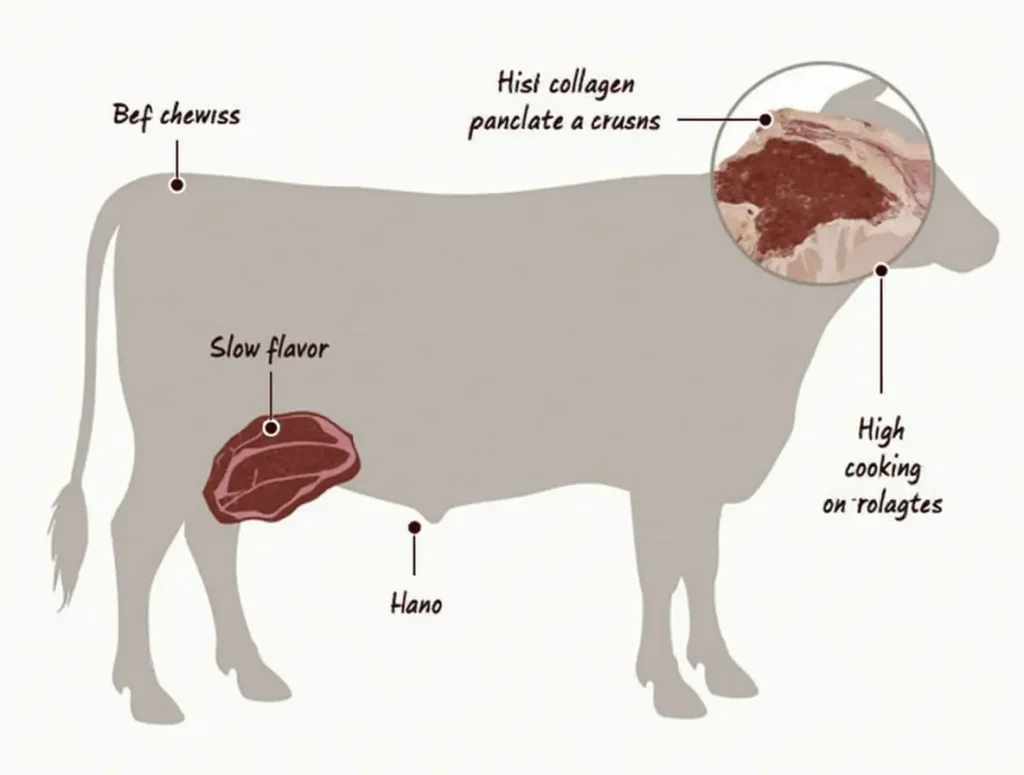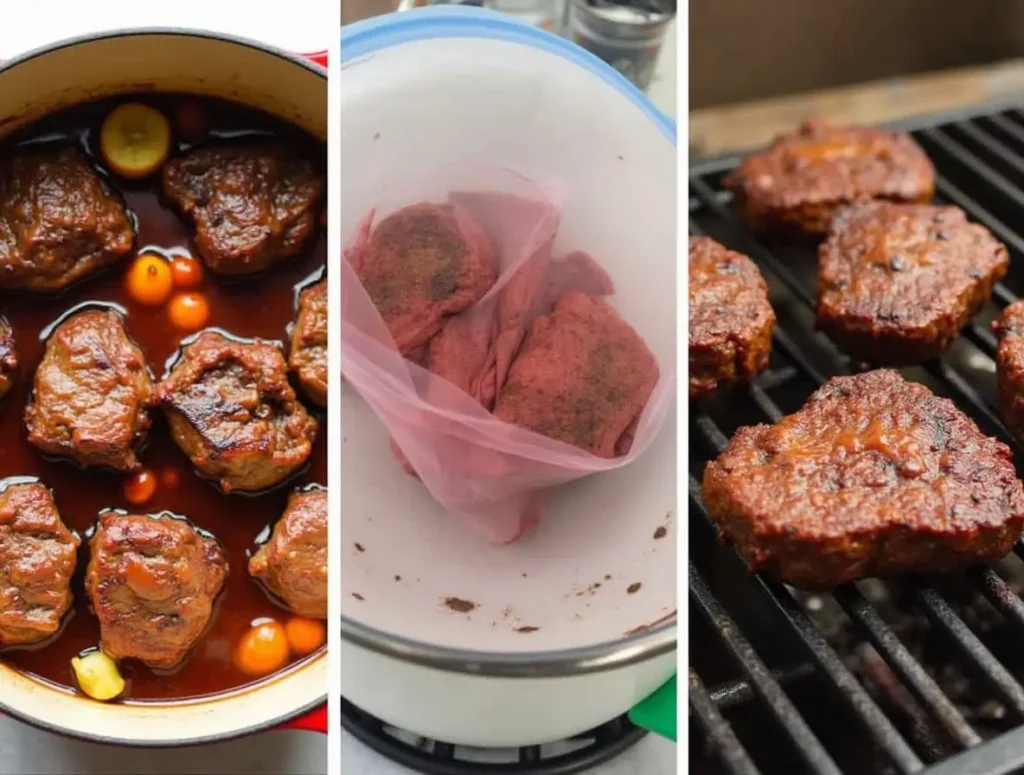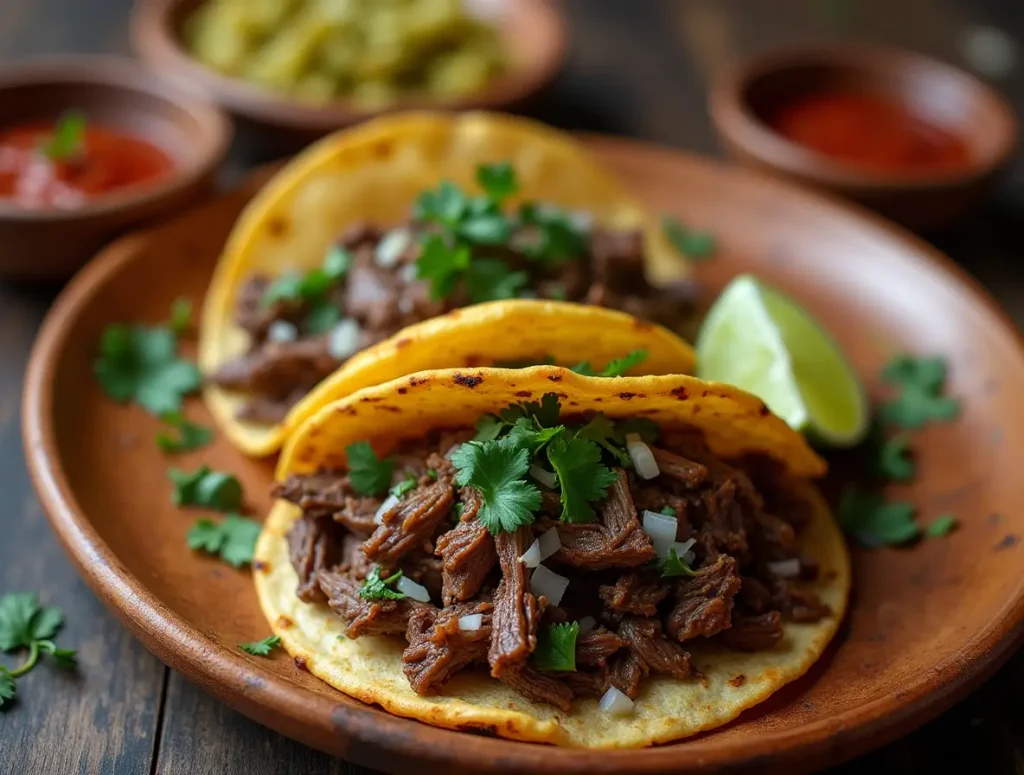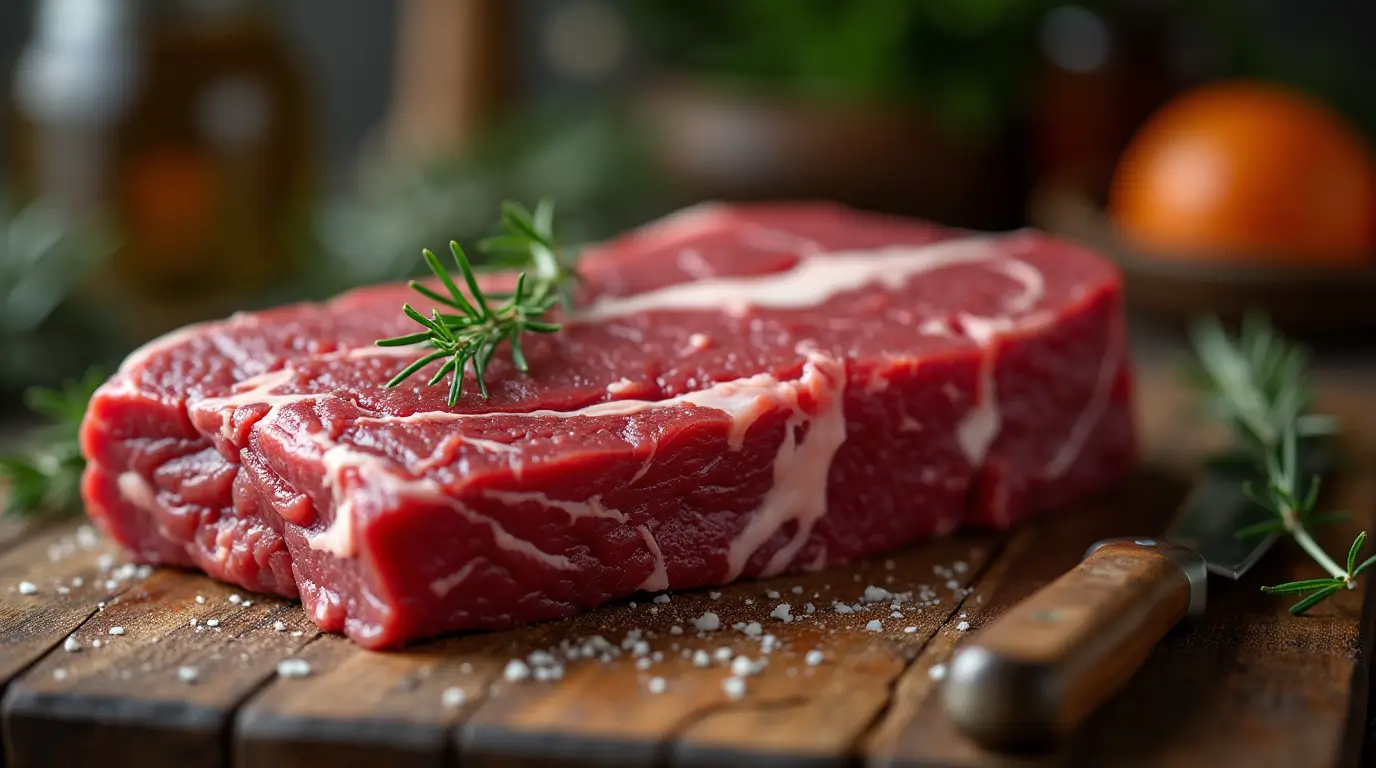What Is Beef Cheek Meat?
Beef cheek meat might just be the most underrated cut you’ve never cooked — but once you try it, there’s no going back. Packed with rich flavor and melt-in-your-mouth tenderness, this cut has long been a secret weapon in professional kitchens.
In this guide, you’ll discover exactly what beef cheek meat is, why it’s gaining popularity among food lovers, and how to cook it like a pro — whether you’re braising, slow-cooking, or trying it sous vide. Get ready to transform a humble cut into a show-stopping dish.
Table of Contents

What Is Beef Cheek Meat? Understanding This Unique Cut
Where Beef Cheeks Come From
Beef cheeks are derived from the cheek muscles of a cow, an area that gets a lot of movement as the animal chews and grazes throughout its life. Because of this constant muscle activity, beef cheeks develop a high amount of connective tissue and collagen, which gives the meat its unique texture.
For official guidelines on beef cuts and meat quality, refer to the USDA’s Beef from Farm to Table resource. This guide provides in-depth information on different beef cuts, handling safety, and cooking recommendations.
Unlike other well-marbled cuts like ribeye, beef cheeks don’t have large streaks of fat running through them. Instead, their richness comes from the collagen, which slowly breaks down when cooked over a long period, resulting in a soft, gelatinous, and ultra-tender texture.
Culinary traditions across the world make use of beef cheeks:
- In Italy, beef cheeks are often braised in red wine for a luxurious ragu.
- In Mexico, they are slow-cooked and shredded for tacos (barbacoa).
- In France, they are a staple in dishes like boeuf bourguignon.
- In Asian cuisine, they are simmered in soy sauce, ginger, and spices for a rich umami flavor.
RELATED : How to Make the Best Beef Chow Fun Recipe at Home
Texture and Flavor Profile
Beef cheeks are unlike many other beef cuts due to their dense muscle structure. They start out firm and fibrous but undergo a dramatic transformation when slow-cooked.
- Marbling & Connective Tissue: While they don’t have large amounts of intramuscular fat, they are loaded with collagen and connective tissue, which turns into a silky, gelatinous consistency when cooked properly.
- Flavor Profile: Beef cheek meat has an intensely beefy, deep, and robust flavor. It absorbs seasonings and braising liquids exceptionally well, making it an ideal cut for rich, saucy dishes.
- Mouthfeel: When cooked low and slow, the collagen melts into the meat, creating a luxurious texture that almost dissolves in your mouth.
Why Beef Cheeks Need Slow Cooking
Because beef cheeks are a hardworking muscle, they require long, slow cooking methods to achieve tenderness. Cooking them quickly—like you would a steak—would result in an extremely tough and chewy bite.
The slow-cooking process breaks down the collagen, transforming the firm muscle fibers into silky, fork-tender meat. Here’s why it works:
- Collagen Breakdown: The abundant collagen in beef cheeks melts at around 160-180°F (71-82°C), turning into a gelatin-like texture that keeps the meat moist and flavorful.
- Extended Cooking Time: Braising for 3-4 hours or using a slow cooker for 6-8 hours ensures the connective tissue fully softens, resulting in that signature melt-in-your-mouth bite.
- Best Cooking Methods:
- Braising: Cooking beef cheeks in a flavorful broth or sauce for several hours enhances tenderness.
- Slow Cooking: Perfect for making shredded beef cheeks for tacos, sandwiches, or rice bowls.
- Sous Vide: A precise way to cook beef cheeks at a low temperature for 24-48 hours, yielding unparalleled juiciness.
- Smoking: When slow-smoked, beef cheeks take on a rich, smoky depth while maintaining their incredible tenderness.
How to Prepare Beef Cheek Meat Before Cooking
Preparing beef cheek meat before cooking is essential to achieving the perfect texture and flavor. This cut requires careful attention to detail to remove excess fat and connective tissue, and the right seasoning will elevate the beef’s rich flavor. Once prepped, it can be cooked using several methods, each offering a unique result. Here’s how to ensure that your beef cheek is properly prepared and ready for cooking.
Trimming & Cleaning the Meat
Beef cheeks often come with a fair amount of silver skin (a thin, silver-colored membrane) and fat that should be removed before cooking. Proper trimming will ensure your dish isn’t greasy and that the collagen in the meat breaks down smoothly, leading to tender results.
- Removing Silver Skin: The silver skin is a thin, tough membrane that doesn’t break down during cooking, which could affect the texture of your beef cheeks. Use a sharp paring knife to carefully slide under the silver skin and gently peel it away. It’s best to do this step when the beef cheeks are cold, as it helps to keep the meat firmer.
- Trimming Excess Fat: While some fat will melt during cooking and add flavor, too much can leave the dish greasy. Trim off large pockets of fat around the meat and the connective tissue that might not break down. Aim for a thin layer of fat to retain flavor without overwhelming the dish.
- Cleaning: After trimming, give the beef cheeks a quick rinse under cold water to remove any residual blood or debris. Pat them dry with paper towels to remove excess moisture, as this will help in the seasoning process and prevent steaming during cooking.
Seasoning Tips for the Best Flavor
Beef cheeks are flavorful on their own, but the right seasoning can take them to the next level. Since they’re a tougher cut of meat, seasoning and marinating are essential for maximizing flavor and tenderizing the meat. Here are some tips to ensure your beef cheeks are seasoned to perfection.
- Salt and Pepper: Sometimes, simple seasoning is the best way to go. A generous amount of kosher salt and freshly ground black pepper will bring out the natural flavors of the beef. Season the beef cheeks at least 30 minutes before cooking to allow the salt to penetrate the meat.
- Marinades: Marinating beef cheeks for several hours—or even overnight—will infuse them with flavor and help tenderize the meat. Popular ingredients for marinades include garlic, soy sauce, red wine, balsamic vinegar, and herbs like rosemary and thyme.
- Dry Rubs: A dry rub is a great way to create a flavorful crust on the beef cheek during cooking. Combine spices like paprika, cumin, chili powder, and brown sugar for a balanced rub that enhances the beef’s natural flavor. You can also add dried herbs or ground mustard for added complexity.
- Aromatics: Don’t forget about aromatics like onions, garlic, and fresh herbs. These can be used as part of a marinade or added directly to the cooking liquid to deepen the flavors during slow-cooking or braising.
Best Cooking Methods for Beef Cheeks
Beef cheeks benefit from long, slow cooking methods that allow the collagen and connective tissue to break down, resulting in incredibly tender, juicy meat. Here are the best ways to cook beef cheeks, each bringing out different flavors and textures.
- Slow Cooking (Crockpot/Slow Cooker):
The slow cooker is one of the easiest and most reliable methods for cooking beef cheeks. This method ensures that the meat gets tender while retaining its rich flavor. To slow-cook beef cheeks:- Add your trimmed beef cheeks to the slow cooker.
- Pour in your choice of broth, stock, or wine, along with seasonings and aromatics.
- Set the slow cooker on low for 6-8 hours or until the meat is tender and easily shreddable.
- This method is ideal for shredded beef cheek tacos or stews.
- Braising (Dutch Oven):
Braising beef cheeks involves searing the meat in a hot pan to develop a rich, caramelized crust, then cooking them slowly in a flavorful liquid. The Dutch oven is perfect for braising because it evenly distributes heat, and the tight-fitting lid locks in moisture. Here’s how to braise:- Preheat a Dutch oven and Brown the beef cheeks on all sides until a deep, golden crust forms.
- Add broth, wine, or a combination of both to cover the meat halfway.
- Add aromatics like onions, garlic, and fresh herbs.
- Cover and bake in a preheated 325°F (160°C) oven for 3-4 hours, or until the meat becomes tender enough to shred with a fork.
- Braised beef cheeks work wonderfully in hearty dishes like ragu or stew.
- Sous Vide:
For precise control over cooking, sous vide is an excellent choice. Cooking beef cheeks sous vide allows the meat to become ultra-tender while maintaining moisture. Here’s how to do it:- Season and vacuum-seal the beef cheeks with your choice of spices and aromatics.
- Set the sous vide water bath to 165°F (74°C) for 24-48 hours.
- After cooking, quickly sear the meat in a hot pan for a flavorful crust.
- Sous vide cooking ensures a consistent texture and juicy beef cheeks, making them ideal for slicing or serving whole.
- Smoking:
If you’re looking for an intense flavor, smoking beef cheeks imparts a rich, smoky essence while keeping the meat incredibly moist and tender. Here’s how to smoke beef cheeks:- Preheat your smoker to around 225°F (107°C).
- Season the beef cheeks with a dry rub or just salt and pepper.
- Smoke the beef cheeks for 4-6 hours, or until they reach an internal temperature of 200°F (93°C), which ensures the collagen is fully broken down.
- Smoking works best for dishes like smoked barbacoa beef cheeks or smoked beef cheek tacos.
Note Chef’s
Properly preparing beef cheek meat is essential to unlocking its full potential in flavor and texture. Whether you choose to trim excess fat, marinate, or use a dry rub, the right preparation ensures your beef cheeks will shine. And with the right cooking method—whether it’s slow cooking, braising, sous vide, or smoking—you’ll end up with tender, flavorful beef cheeks that make any dish extraordinary.

Best Ways to Cook Beef Cheeks for Maximum Tenderness
Beef cheeks are known for their rich, beefy flavor and tender texture, but to truly unlock their potential, they need to be cooked slowly or with precision. Whether you’re using a Dutch oven, pressure cooker, sous vide, or smoker, each method offers a unique approach to achieving tender beef cheeks. Here’s a guide to the best ways to cook this cut of meat, ensuring you get the most flavorful and melt-in-your-mouth results every time.
Slow-Cooked or Braised Beef Cheeks
Slow cooking or braising beef cheeks is one of the best ways to break down the tough connective tissue and collagen, leaving you with incredibly tender meat. The process requires patience, but the results are well worth the wait. Whether you’re using a Dutch oven or a slow cooker, this method is foolproof for achieving fork-tender beef cheeks.
- Using a Dutch Oven:
- Start by searing the beef cheeks in a hot Dutch oven to develop a rich, caramelized crust.
- After browning, add a liquid like beef broth, red wine, or tomato paste, along with your choice of aromatics (onions, garlic, and herbs like thyme and rosemary).
- Cover the Dutch oven with a tight-fitting lid and cook at a low heat (around 325°F/160°C) in the oven for 3-4 hours or until the beef cheeks are tender and easily shredded.
- The slow, steady heat allows the collagen to break down completely, giving the beef cheeks a rich, melt-in-your-mouth texture. Braised beef cheeks are ideal for stews, tacos, or served as a main course.
- Using a Slow Cooker:
- Place the trimmed beef cheeks into the slow cooker with a flavorful broth or sauce (like a combination of beef stock and red wine).
- Add seasonings, herbs, and aromatics such as onions, garlic, and bay leaves.
- Set the slow cooker to low and cook for 6-8 hours, or until the meat is tender enough to fall apart.
- This method is perfect for those who prefer a hands-off approach and want to come home to perfectly cooked beef cheeks. Slow-cooked beef cheeks are often used for shredded beef dishes like sandwiches or tacos.
Pressure Cooker & Instant Pot Method
For those short on time but craving the same tender, juicy beef cheeks, using a pressure cooker or Instant Pot is an excellent choice. These cooking methods significantly reduce cooking time while still producing results that are just as tender as slow cooking.
- Using a Pressure Cooker or Instant Pot:
- Sear the beef cheeks in the Instant Pot or pressure cooker on the Sauté setting to build a flavorful crust.
- After searing, add your liquid (such as broth or wine) and aromatics (like garlic, onions, and bay leaves).
- Seal the lid and cook on high pressure for 50-60 minutes, depending on the size of the beef cheeks.
- Once cooking is done, allow the pressure to release naturally before opening the lid. The collagen and connective tissue break down quickly under pressure, leaving you with fork-tender beef cheeks in a fraction of the time compared to slow cooking.
- Pressure-cooked beef cheeks work wonderfully in rich, saucy dishes like stews or served alongside mashed potatoes or rice.
Sous Vide Beef Cheeks for Ultimate Precision
Sous vide is a precise and hands-off cooking method that allows you to control the exact temperature at which the beef cheeks are cooked. This technique guarantees the most consistent tenderness and juiciness because the beef is cooked in a vacuum-sealed bag in a water bath for an extended period. Sous vide cooking ensures that the beef cheeks retain their natural juices, making them incredibly flavorful and moist.
- Using Sous Vide:
- Season the beef cheeks generously with your choice of herbs, spices, and a bit of salt.
- Vacuum-seal the beef cheeks in a bag or use a Ziploc bag with the water displacement method.
- Submerge the sealed bag in a preheated water bath set to 165°F (74°C) for 24-48 hours. The longer you cook, the more tender the meat becomes, as the collagen continues to break down.
- After sous vide cooking, remove the beef cheeks from the bag and sear them quickly in a hot skillet to create a flavorful crust.
- This method is ideal for precise control over the doneness of the meat, and the result is juicy, tender beef cheeks with an incredibly rich flavor. Sous vide beef cheeks are perfect for serving in gourmet dishes or for high-end meals.
Smoked Beef Cheeks for a Bold, BBQ Flavor
Smoking beef cheeks adds a bold, smoky flavor that transforms this cut into an extraordinary dish. The long cooking time and the smoky environment work together to break down the tough tissues while infusing the meat with a rich, charred flavor that’s perfect for BBQ-style dishes.
- Using a Smoker:
- Preheat your smoker to around 225°F (107°C).
- Season the beef cheeks with a dry rub (such as paprika, cumin, garlic powder, and brown sugar) or simply with salt and pepper for a more minimalist approach.
- Place the beef cheeks on the smoker and cook for about 4-6 hours, or until the internal temperature reaches 200°F (93°C). The long cooking time allows the collagen to break down slowly, resulting in ultra-tender meat.
- During the smoking process, you’ll also get a delicious smoky flavor that complements the rich beef flavor.
- Smoked beef cheeks are fantastic when used in BBQ beef cheek tacos, sandwiches, or served alongside grilled vegetables for a hearty, flavorful meal.
Conclusion
Each of these methods—slow cooking, pressure cooking, sous vide, and smoking—offers a different experience for cooking beef cheeks, but they all share one goal: achieving maximum tenderness. Whether you prefer the simplicity of a slow cooker, the precision of sous vide, or the boldness of smoking, beef cheeks are a versatile cut that can shine in a variety of dishes. Choose the method that best suits your time, tools, and desired flavor profile, and enjoy this richly flavored, tender meat at its finest.
Delicious Beef Cheek Recipes to Try at Home
Beef cheeks are an incredibly flavorful and tender cut of meat that can be transformed into a variety of delicious dishes. Whether you’re looking for a hearty comfort meal, a bold and spicy taco filling, or a savory pasta sauce, these recipes highlight the best ways to prepare beef cheeks for a mouthwatering experience.
Classic Braised Beef Cheeks in Red Wine
Rich, hearty, and deeply flavorful, this French-inspired dish is a perfect way to showcase the melt-in-your-mouth texture of beef cheeks.
Ingredients:
- 2 lbs beef cheeks (trimmed of excess fat and silver skin)
- 2 tbsp olive oil
- 1 onion (chopped)
- 2 carrots (diced)
- 3 garlic cloves (minced)
- 2 cups red wine (preferably a dry variety like Cabernet Sauvignon or Merlot)
- 2 cups beef broth
- 2 tbsp tomato paste
- 1 tsp thyme (fresh or dried)
- 2 bay leaves
- Salt and pepper to taste
Instructions:
- Sear the Beef Cheeks: In a Dutch oven, heat olive oil over medium-high heat. Sear the beef cheeks on all sides until browned. Remove and set aside.
- Sauté the Aromatics: In the same pot, add onions, carrots, and garlic. Sauté until softened.
- Deglaze with Red Wine: Pour in red wine, scraping up any browned bits from the bottom of the pot. Let it reduce by half.
- Braise: Add the beef cheeks back to the pot along with beef broth, tomato paste, thyme, and bay leaves. Cover and simmer on low for 3-4 hours, or until the meat is fork-tender.
- Serve: Remove bay leaves and serve with mashed potatoes, polenta, or crusty bread.

Beef Cheek Tacos with Mexican Spices
Slow-cooked, shredded beef cheeks packed with bold flavors, served in warm tortillas with fresh toppings.
Ingredients:
- 2 lbs beef cheeks
- 2 tbsp olive oil
- 1 onion (sliced)
- 3 garlic cloves (minced)
- 2 cups beef broth
- 1 tbsp chili powder
- 1 tsp cumin
- 1 tsp smoked paprika
- ½ tsp oregano
- Juice of 1 lime
- Corn or flour tortillas
- Toppings: chopped cilantro, diced onions, sliced radishes, avocado, salsa
Instructions:
- Sear the Beef Cheeks: In a slow cooker or Dutch oven, heat olive oil and sear the beef cheeks until browned.
- Add Aromatics & Spices: Add onions, garlic, beef broth, chili powder, cumin, paprika, and oregano.
- Slow Cook: Cover and cook on low for 6-8 hours (or high for 4-5 hours) until the beef is tender and easily shredded.
- Shred the Meat: Remove the beef cheeks, shred with forks, and mix with lime juice for extra flavor.
- Assemble Tacos: Warm the tortillas, fill with shredded beef, and top with cilantro, onions, radishes, avocado, and salsa.
Asian-Style Soy-Braised Beef Cheeks
A tender, umami-packed dish with deep soy sauce, ginger, and garlic flavors—perfect for serving over rice or noodles.
Ingredients:
- 2 lbs beef cheeks
- 2 tbsp vegetable oil
- 4 garlic cloves (minced)
- 1-inch ginger (grated)
- 1 cup soy sauce
- ½ cup mirin or rice wine
- ½ cup beef broth or water
- 2 tbsp brown sugar
- 1 tsp five-spice powder
- 1 star anise
- Green onions and sesame seeds (for garnish)
Instructions:
- Sear the Beef Cheeks: In a heavy pot or Dutch oven, heat oil and brown the beef cheeks on all sides. Remove and set aside.
- Prepare the Braising Liquid: In the same pot, sauté garlic and ginger until fragrant. Add soy sauce, mirin, beef broth, brown sugar, five-spice powder, and star anise.
- Braise: Return the beef cheeks to the pot, cover, and simmer on low for 3-4 hours until fork-tender.
- Slice & Serve: Remove from the sauce, slice or shred, and serve over steamed rice or noodles. Garnish with green onions and sesame seeds.
Beef Cheek Ragu for Pasta Lovers
A slow-cooked, rich, and hearty Italian-style sauce perfect for pairing with pappardelle, rigatoni, or polenta.
Ingredients:
- 2 lbs beef cheeks
- 2 tbsp olive oil
- 1 onion (diced)
- 2 carrots (chopped)
- 3 garlic cloves (minced)
- 1 can (28 oz) crushed tomatoes
- 1 cup beef broth
- 1 cup red wine
- 1 tbsp tomato paste
- 1 tsp dried oregano
- 1 tsp basil
- Salt & pepper to taste
- Fresh pasta (pappardelle or rigatoni)
- Parmesan cheese & fresh basil (for garnish)
Instructions:
- Sear the Beef Cheeks: Heat olive oil in a large pot and sear the beef cheeks until browned. Remove and set aside.
- Cook the Aromatics: Sauté onions, carrots, and garlic until softened. Stir in tomato paste and cook for 1-2 minutes.
- Deglaze & Simmer: Pour in red wine, let it reduce by half, then add crushed tomatoes, beef broth, oregano, and basil.
- Slow Cook: Return the beef cheeks, cover, and let simmer on low for 3-4 hours until tender. Shred the meat into the sauce.
- Serve: Toss the sauce with freshly cooked pasta, garnish with parmesan cheese and fresh basil.
Final Thoughts
Beef cheeks are a versatile cut that can be transformed into a variety of incredible dishes, from comforting braised dishes to bold tacos and flavorful Asian-inspired meals. Whether you’re in the mood for hearty pasta, slow-cooked tacos, or savory soy-braised beef, these recipes will help you make the most of this underrated cut of meat.
Where to Buy Beef Cheek Meat & Storage Tips
Beef cheek meat is a flavorful, collagen-rich cut that can elevate your cooking, but it’s not always as readily available as other beef cuts. Knowing where to buy it, how to store it properly, and what mistakes to avoid will help you get the best results when preparing this tender delicacy.
Best Places to Buy Beef Cheeks
Since beef cheeks are not as commonly stocked as steaks or ground beef, you might need to source them from specific places:
1. Local Butcher Shops
- Many independent butcher shops carry specialty cuts like beef cheeks, especially if they focus on whole-animal butchery.
- You can request a special order if it’s not available in-store.
2. Specialty Meat Markets
- High-end or gourmet meat markets often stock beef cheeks due to their popularity in slow-cooked gourmet dishes.
- Some specialty markets may sell wagyu beef cheeks, which are even more tender and rich in flavor.
3. Online Meat Retailers
- Websites like Porter Road, Snake River Farms, or Crowd Cow offer beef cheeks for home delivery.
- Online ordering allows you to access high-quality, grass-fed, or organic options if you prefer.
4. Farmers’ Markets & Local Farms
- Some small-scale beef farms sell directly to consumers and may have beef cheeks available as part of bulk beef purchases.
- Buying directly from farmers ensures fresh, pasture-raised beef with higher traceability.
5. Restaurant Suppliers or Wholesale Clubs
- If you need a larger quantity, restaurant supply stores like Restaurant Depot or Costco Business Centers might carry beef cheeks in bulk.
- You may need a business membership to purchase from some suppliers.
How to Store & Freeze Beef Cheeks Properly
Proper storage ensures that beef cheeks retain their flavor, texture, and quality for as long as possible.
Fridge Storage (Short-Term Use)
- Store fresh beef cheeks in the coldest part of your refrigerator (usually the back) at 35-40°F (1-4°C).
- Keep them in their original vacuum-sealed packaging or wrap them tightly in plastic wrap and place in an airtight container.
- Use within 3-4 days for the best freshness.
Freezing for Long-Term Use
If you’re not cooking beef cheeks immediately, freezing is the best option:
- Wrap the meat tightly in plastic wrap, followed by aluminum foil, to prevent freezer burn.
- Place in a vacuum-sealed bag or a heavy-duty freezer bag.
- Label the package with the date of freezing for easy tracking.
- Store at 0°F (-18°C) or below for up to 6-12 months for optimal quality.
Thawing Beef Cheeks Safely
- The best method is to thaw beef cheeks in the refrigerator overnight (this preserves texture and flavor).
- If you need to thaw quickly, submerge the sealed meat in cold water, changing the water every 30 minutes.
- Avoid microwave thawing, as it can partially cook the meat unevenly and impact the final texture.
Common Mistakes to Avoid When Cooking Beef Cheeks
Because beef cheeks are a tough, collagen-heavy cut, they require specific preparation methods to achieve their best texture and flavor. Here are some key mistakes to avoid:
1. Not Slow-Cooking Long Enough
- Beef cheeks have a high collagen content, which needs low and slow cooking to break down into silky, melt-in-your-mouth gelatin.
- If you don’t cook them long enough, they can remain tough and chewy instead of fork-tender.
- The ideal cooking time:
- Slow cooker: 6-8 hours on low
- Braising: 3-4 hours on low heat
- Sous vide: 24-48 hours at 165°F (74°C)
2. Under-Seasoning the Meat
- Since beef cheeks are a rich and flavorful cut, they need bold seasoning to complement their taste.
- Always season with salt and pepper at a minimum. Marinades, spice rubs, or braising liquids with wine, soy sauce, or aromatic herbs can enhance the flavor.
3. Not Trimming Excess Fat or Silver Skin
- Beef cheeks often have a layer of silver skin and connective tissue that won’t break down completely during cooking.
- While some fat adds flavor, excess fat and tough sinew should be trimmed for a better texture.
- Ask your butcher to trim them or use a sharp knife to remove silver skin and large fat pockets before cooking.
4. Using the Wrong Cooking Method
- Beef cheeks need moist heat cooking, such as braising, slow cooking, or sous vide.
- Avoid grilling or pan-frying alone, as they won’t get tender enough without slow cooking first.
- If you want to grill or sear them for extra flavor, do it after braising or sous vide cooking.
5. Rushing the Resting Time
- After cooking, let beef cheeks rest for 10-15 minutes before slicing or shredding.
- This helps redistribute the juices and makes the meat even more tender and flavorful.
Final Thoughts
Finding and preparing beef cheek meat doesn’t have to be difficult if you know where to buy it, how to store it properly, and what common mistakes to avoid. Whether you’re slow-braising them in red wine, shredding them for tacos, or smoking them for a BBQ feast, beef cheeks are a unique and delicious cut that rewards patience with incredible texture and deep, rich flavor.
Would you like me to add any product recommendations for where to buy beef cheeks online, or include a step-by-step trimming guide?
Conclusion
Beef cheek meat is a hidden gem in the culinary world, offering a rich, melt-in-your-mouth texture when cooked properly. While it may not be as widely available as other cuts, sourcing it from butcher shops, specialty markets, or online retailers ensures you get high-quality meat for your dishes.
Mastering the slow-cooking process—whether through braising, sous vide, or smoking—is the key to unlocking its full potential. With the right preparation, seasoning, and cooking method, beef cheeks transform into an incredibly tender and flavorful dish perfect for everything from hearty stews to gourmet tacos.
By avoiding common mistakes like under-seasoning, skipping trimming, or not cooking long enough, you’ll achieve restaurant-quality results right in your kitchen. Whether you’re a home cook looking to try something new or a seasoned chef exploring unique cuts of meat, beef cheeks offer a rewarding and delicious cooking experience.
Have you cooked beef cheeks before? Share your favorite recipe or cooking tips in the comments below! If you’re trying beef cheek meat for the first time, let us know which method you’ll be using. Happy cooking!
Last Updated on August 6, 2025 by Carla



1 thought on “Beef Cheek Meat for Beginners: Everything You Need to Know to Master It”